
2016 is a big year for ski touring. Traditionally the ski touring market has be dominated by brands which more or less, solely made products for ski touring such as Dynafit and Scarpa and the larger alpine brands tended to stay away.
However in recent years there has been a change in what people are doing on the mountain. Products like the Marker Duke binding really changed the way skiers looked at the mountain and in the years since nearly all the brands have jumped on the backcountry train.
Although these products allowed a great number of people to get there first experiences in the backcountry, the freeride touring gear was and still is rather heavy. The more you get into touring the more you can understand the desire for lighter gear, and it's at this point many people jump ship from the more established brands and try gear from the more specialized brands.
Salomon and Atomic both made "touring" boots in the past but to be honest neither compared to what was on the market from their competitors. They weighed more then the competition and were basically modified freeride boots, not really true touring boots.
Jump ahead to the 2016 season and both brands have brand new boots and this time they actually look to have something really different, so will these finally be the boots which break the touring market for the bigger brands.
Overview
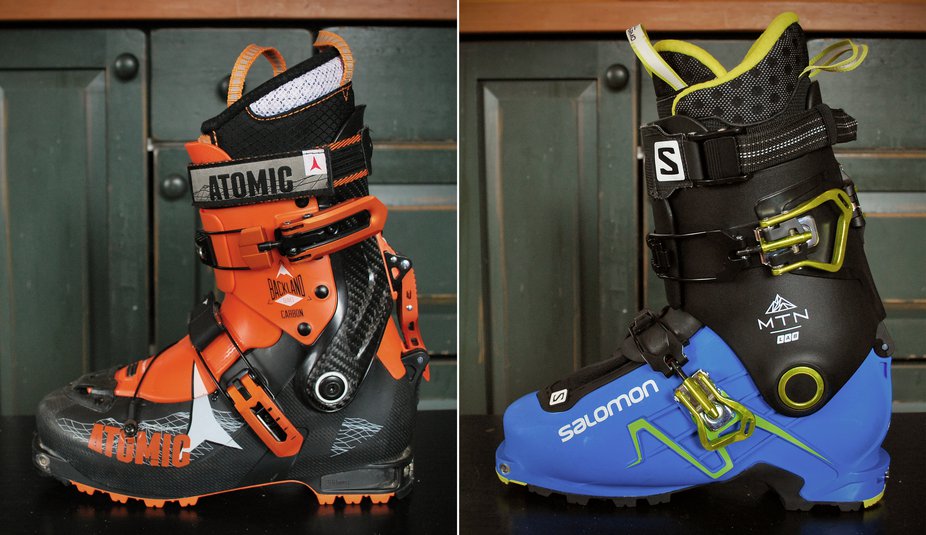
Side by side the boots do look very different and this brings up my first point. Yes everyone knows Salomon and Atomic are both owned by Amer but this does not mean they are the same company. All development and production is kept completely separate and the only technology and research shared is on the binding side. So these are two different boots, but that is pretty obvious looking at them.
The Salomon I would be testing is the 2016 MTN Lab. Salomon are offering two touring boots next season, the MTN Lab and the MTN Explore. The Explore, which is slightly lighter (1462g) is the more dedicated touring version. It has a slightly softer flex but it does have a greater range as motion (ROM) then the Lab version and is available in smaller sizes so could be a good woman's option. The Lab version is the model for the more aggressive skier. Salomon claim it could be as much as 80% alpine and only 20% touring, so would it be more a traditional freeride boot with a slightly better walk mode?
The Atomic I would be testing is the 2016 Backland Carbon. Again not the lightest version, Atomic also have the Backland Carbon Light (942g!), this version is again the version more suited to more aggressive riding, however unlike the MTN Lab, the Backland at heart is a light weight touring boot, so the expectations of the riding being done is much less aggressive, so would this mean the Backland will get you to the top but would you struggle on the way back down?
I would be testing both boots with a variety of skis ranging from 95mm right up to 115mm and in the case of the MTN Lab I would be testing with both tech and alpine style bindings. The Backland only works with tech bindings so I would be using the Dynafit Radical ST bindings.
To try to give a thorough test I would be trying the boots in a variety of terrains both up and downhill and for the most part, even though the boots were designed with very different skiing in mind, I would try to test them in a similar manner just to see how far you could push the boots if you needed.
So enough talking, on to the boots.
Weight
Probably the one aspect people concentrate on the most when it comes to touring gear is weight. Weight is an understandable concern when you have to carry that weight uphill every step but there is usually a trade off between weight saving and downhill performance.
When it comes to weight the Atomic certainly takes the lead, at 1122g per boot (in size 26) they really are very light. To put that into perspective an average alpine boot will be around 2200g, so one of your boots weighs the same as a pair of these boots.
The Salomon is not quite as light at 1550g per boot but this still puts it 475g lighter then the Quest Max 120 and again much lighter then an average alpine boot.
But how do these numbers compare to touring boots currently on the market? If you look online you will find boots like the Dynafit Dyna Evo and the Scarpa Alien which advertise crazy weights, 678g and 700g, but neither is a boot I would want to tackle a steep, technical descent in.
It is perhaps better to compare boots like the Dynafit TLT 6 and Mercury.
The TLT6 is a lightweight touring boot weighing in at 1225g and the Mercury is the high performance touring boot, which weighs 1600g. These two boots compare pretty well to the Atomic and Salomon. In both cases the Alpine brand takes a slight lead in weight so for all the gram counters out there, there should be no issues when it comes to weight of either boot.
Shell Construction
Much of the weight saving on both boots is accomplished by using a very thin wall for the boot shell. By finding a way to make the shell as thin as possible while still maintaining a firm feel both brands have been able to save a lot of weight.
Both boots use a similar construction favoring Grilamid for the lower shell, a material used on a number of higher end touring boots such as the Dynafit Vulcan. Grilamid is often used in touring boots, along with Pebax, as they have proprieties which are favorable to touring. Along with being lighter weight, unlike a regular PU material used on an alpine boot Grilamid and Pebax do not change stiffness when cold.
You may have noticed your boots stiffen on cold days and this is the plastic stiffening as it gets cold. Grilamid and Pebax will not do this so can offer a much more consistent flex in a large range of conditions.
On big difference between the MTN Lab and the Backland is what Atomic mix with the Grilamid. They add a material called MemoryLink which gives the shell the ability to change shape when hot, then hold that shape when cooled making boot fitting potentially much easier.
Having Memoryfit on the shell really is something unique to the touring market and the fact that Atomic have been able to create such a light weight shell which still maintains the ability to be custom fitted is quite astonishing.
Both boots use a carbon spine although the Backland's is much more obvious. The spine on the MTN Lab is for the most part hidden behind the cuff but you can see a small section of it at the bottom of the cuff. The Backland in comparison has a more conventional design having the cuff and the spine as one piece. The spine on the Backland is molded carbon fiber and the front cuff is riveted directly onto the spine.
The materials used in the cuff differ slightly with the Backland using Grilamid and the MNT Lab going with Pebax.
The cuff itself is very different and one of the most obvious differences when you first try the boots. The cuff on the MTN Lab is a fairly standard shape and size to an alpine boot so feels fairly normal. The Backland has a much shorter overall cuff at the front. By using the tongue as well as the cuff, it almost feels like a 3 piece/ overlap hybrid. It certainly has a unique feel and in terms of the support offered it does feel as though the MTN Lab will do a better job.
Ski/Walk Mechanism
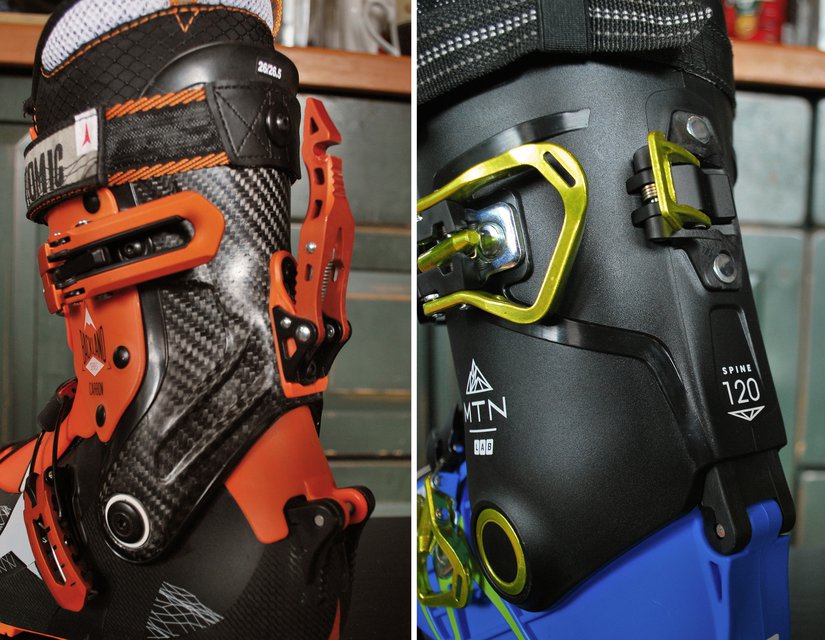
The ski/walk mechanism's are completely different on the Salomon and Atomic and they are also quite different to anything either brand has used before.
On the Quest and Waymaker boots, Salomon and Atomic used a similar wedge system which when removed allows the cuff to pivot backwards. It works OK but does not offer the largest range of motion or the best lock between the cuff and the shell.
Although they have gone different directions for the mechanism both brands have used ideas similar to ones already on the market with Salomon favoring a Dynafit style walk mode whereas Atomic's is similar to that used on the Scarpa Alein, neither is a straight copy and in both cases they do seem to have potentially improved the design.
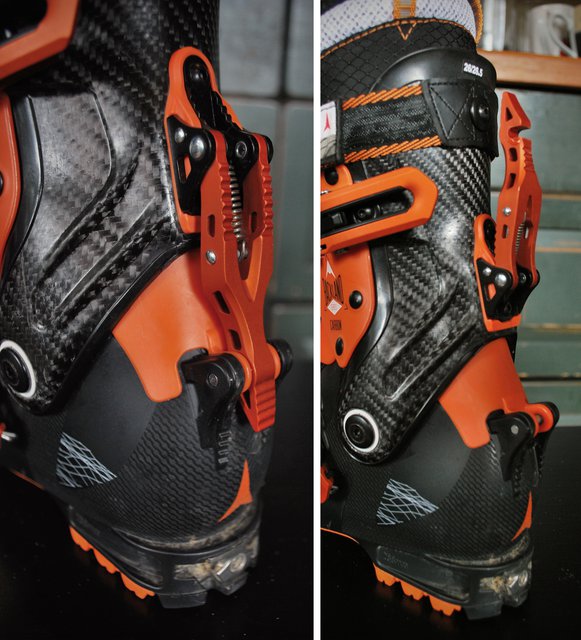
The mechanism on the Backland is easier to understand. It is basically a lever, which when down locks the cuff to the shell at a point at the top of the heel. Pull the lever up and the cuff is free to move. The lever has a spring inside to keep it up when not in ski mode.
When in ski mode, the lever grabs onto a small metal bar which is held in place by a mount molded directly into the shell.
It is very simple but also incredible effective. The lever action feels very strong and when in ski mode there is very little play in the cuff. The connection feels positive and does not feel as though it will give.
The MTN Lab is a little harder to understand as most of it is hidden away inside, however if you have ever seen how the walk mode on a Dynafit boot works it is very similar.
On a Dynafit boot the top buckle also acts as the walk mode. When the buckle is closed a small metal tab on the buckle goes through a hole on the cuff and through to the shell. The buckle is used to lock the cuff and changing it to ski mode is as simple as opening the buckle.
This system has always had one big downside in my opinion, which is if you manage to damage the buckle you are stuck with the boot in walk mode, not ideal if you are miles from help.
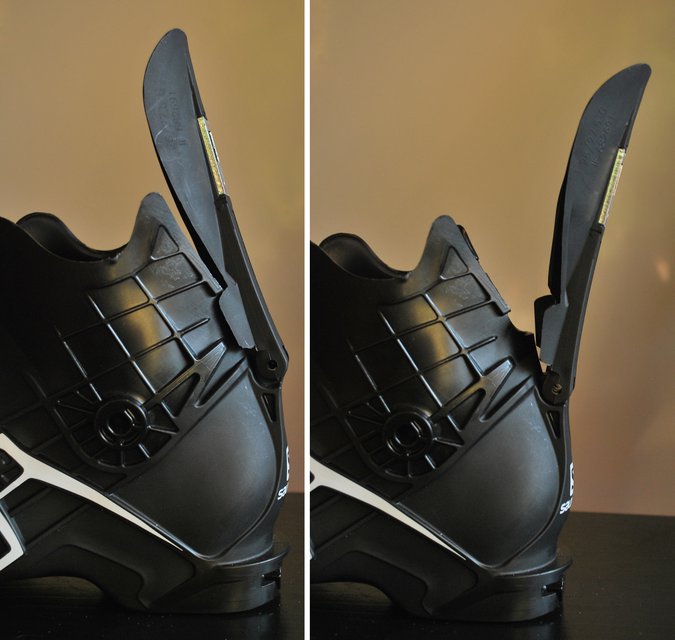
Because the system can be hard to understand, Salmon lent me a demo boot to demonstrate the spine. The left image shows the spine forward like it would be in Ski mode, the right image shows how much the spine can pivot backwards. The cuff sits over the lower shell and this spine.
The system Salomon have gone for is very similar to the method Dynafit use. Beneath the cuff is the spine which is mounted on a pivot at the top of the heel. When upright the spine rests against the lower shell but it has the ability to pivot backwards.
The cuff sits over the lower shell and spine and when the walk mode is activated the cuff and the spine are free to flex rearwards over one another. Importantly though they have different pivot points which means they slide over one another rather then together and this is important for how the walk mode works. When the boot is in ski mode a small block mounted to the cuff goes through a matching hole on the spine. With this connection between the two, the cuff is no longer able to slide over the spine and the rear flex eliminated and the boot is as solid as any alpine boot with a locked cuff.
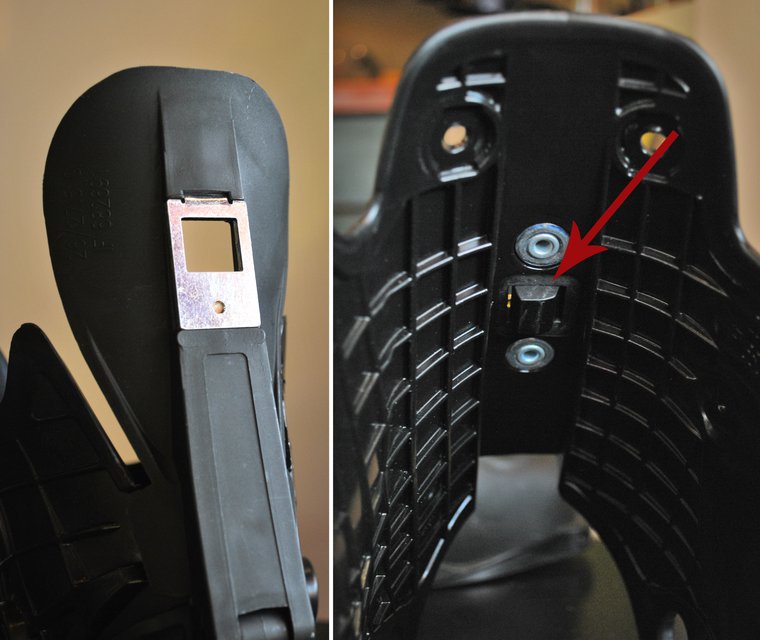
The left image shows the spine with the hole for the cuff block. The red arrow on the right image shows the block which intersects the spine and stops the two sliding over one another when in ski mode.
Although slightly more complex then the Backland it gives if anything an even more solid connection. There is zero play in the cuff and in my opinion is an improvement over the Dynafit design and certainly much better then anything Salomon have used in the past.
Forward Cuff Movement
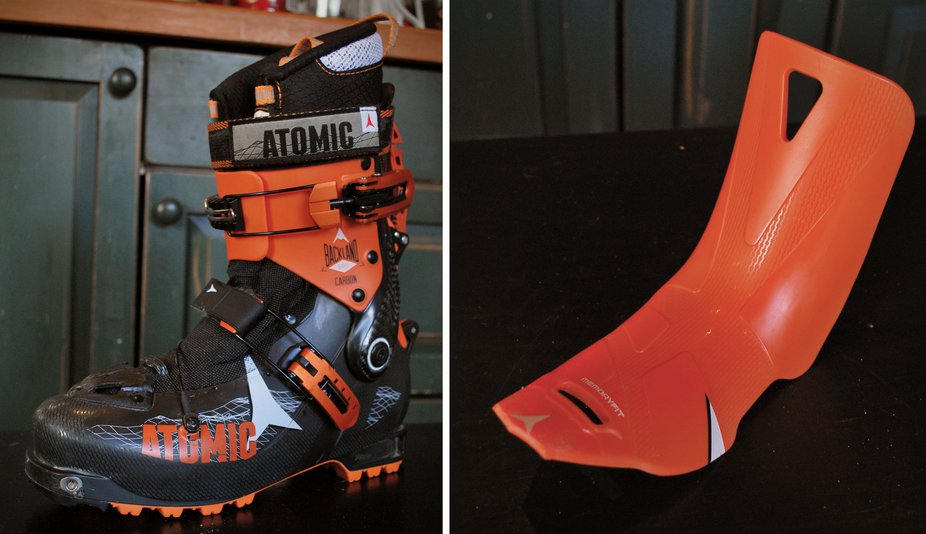
One of the big differences between most of the touring boots on the market and the freeride boots is the amount of forward movement offered when in walk mode.
Most freeride boots do a good job of releasing the cuff backwards but not many soften the flex forwards to give a more natural walking motion.
Many touring boots offer the ability to remove a tongue, a little like that used on Full Tilts, which allows the cuff to move much more freely forward. The tongue can then be re-inserted when you are ready to ski, to stiffen the boot back up.
Salomon and Atomic go very different directions here too, with the Backland offering a more traditional removable tongue and the MTN Lab going for a shell modification similar to that used on the K2 Pinnacle 130 I reviewed last week.
Whereas the Pinnacle uses a V-Cut to soften the forward flex, Salomon choose to use a slightly different system.
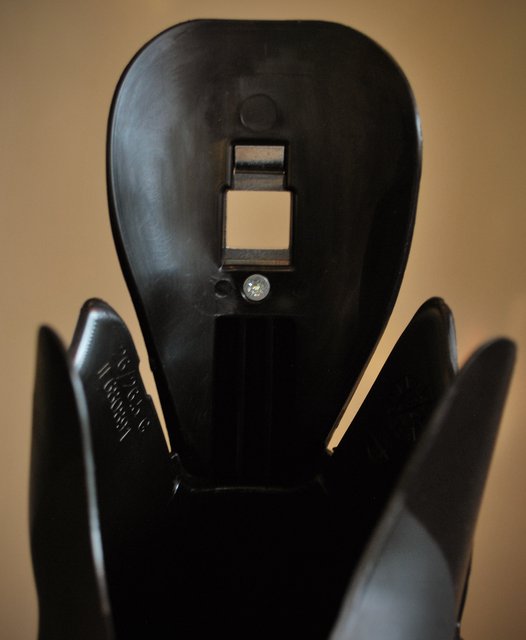
Instead of one large cut, the spine is made slightly smaller then the gap in the back of the lower shell. This small gap allows some forward give in the cuff but it is certainly not as effective as the Backland.
In this respect the Backland certainly feels much more like a traditional touring boot. The walking motion is very, very good and without the tongue really does feel effortless. The pivots for the cuff offer a near zero friction feel and without the tongue the cuff can move as freely as your ankle.
The MTN Lab in comparison feels more like a freeride boot with a much improved walk function. It is certainly a long way ahead that of a Quest or a Waymaker, for example and the rear movement is very good, but the forward flex does have quite an abrupt stop to it and with only 47degrees of ROM it does fall quite a way behind the Backland which has an incredible 74degrees ROM with the tongue removed.
At this point it is worth mentioning again that the other offering for Salomon the MTN Explore does have a greater ROM at 62degrees, so if ROM is a large factor and you don't mind a slightly softer flex the MTN Explore may be worth a look.
Soles
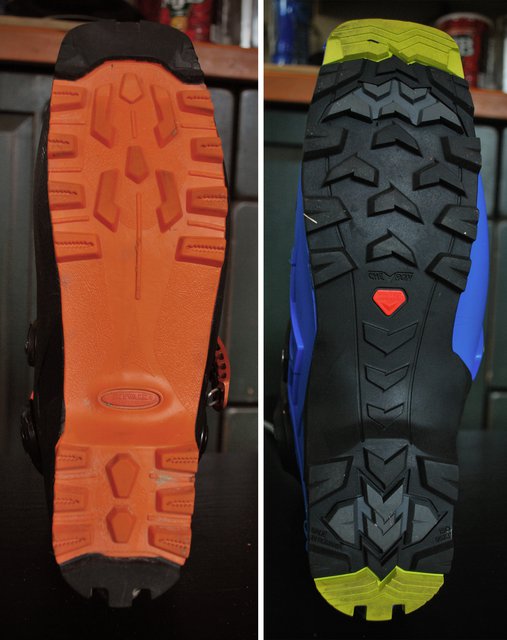
If you were to look at just the soles of the boots, especially the Backland, you could be forgiven for thinking you were looking at a hiking boot.
They certainly look nothing like the boots park riders will be used to riding. The big difference really is the lack of AFD (anti friction device), on a regular boot the AFD works with the binding to help the boots release in the case of a fall.
The lack of an AFD will limit the bindings which can be used, but with boots like this the expectation is that the user is probably going to be using a tech setup. Hopefully you read my Intro to Tech article yesterday so have some understanding of what this means but if not take a look here.
One of the other main differences between these boots and an alpine boot is the sole is slightly curved (rockered) like a normal shoe. An alpine boot has a flat sole and it is this differences in shape which helps this type of boot walk more easily then an alpine boot
Although both boots are tech compatible there is one difference and its a big one.
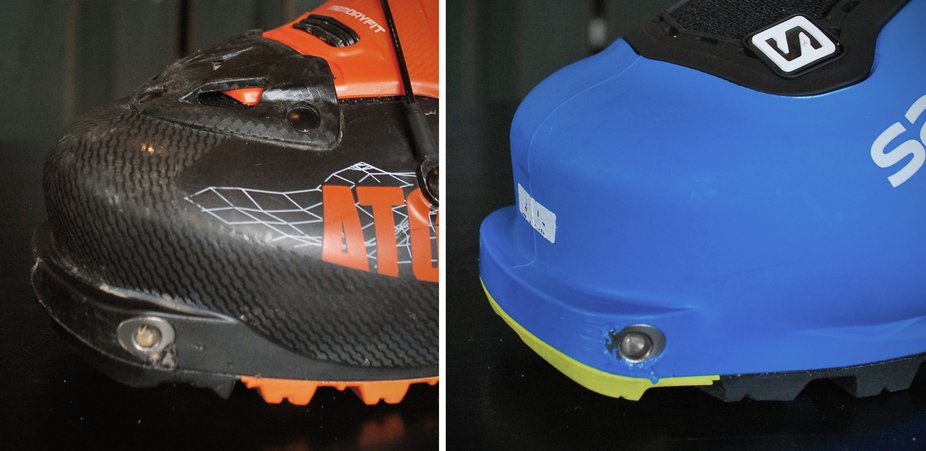
If you look closely at the heel and toe lug of the Backland you will notice they are very short. The MTN Lab in comparison looks more like a traditional boot and that is because, it is. The MTN Lab can be used in bindings such as the Duke or the Guardian or if you want an alpine style binding you could use something like the Salomon Warden. So in terms of binding options the MTN Lab has you fairly well covered for both touring and alpine use.
The Backland in comparison does not have this compatibility, you will be stuck using tech bindings and this more then anything defines how Atomic see this boot being used. However using this short sole method allows the Backland to really play its ace.
By not having to make the sole long enough to fit into bindings, Atomic were able to make the boot sole length (BSL) of a size 26 boot, 288mm. Compare that to the 301mm BSL of the MTN Lab and its easy to see where some of the weight saving comes from.
This shorter overall foot shape also helps give the boot its natural walking motion, which when combined with the rockered sole is probably the best I have ever tried.
Buckles and Strap
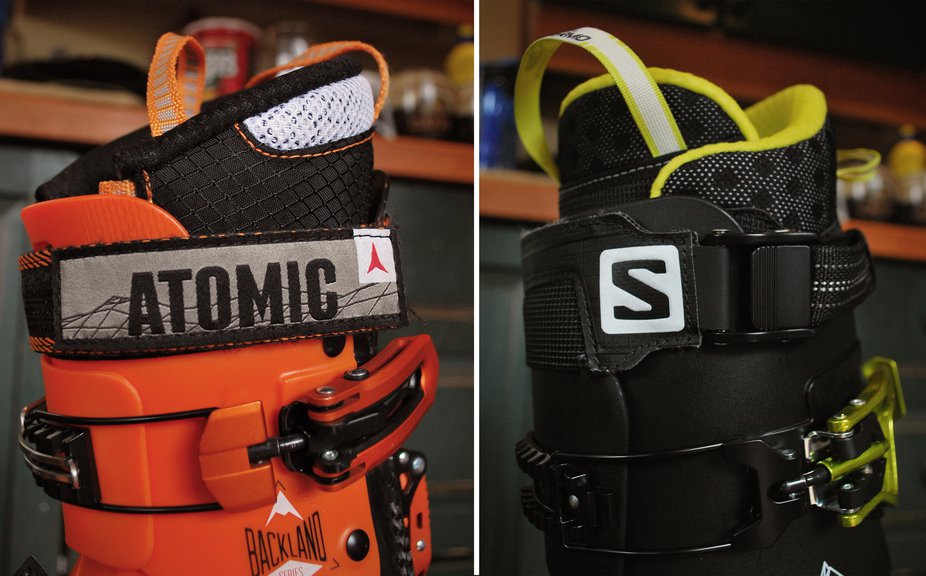
Both boots use a fairly conventional top buckle but to help save weight both have gone for a wire clasp rather then a conventional design.
Both boots offer the option of using the top buckle in open position to better aid the ROM. The MTN Lab only allows you to use the first tooth with the buckle open, something I found to be too loose but the on the Bcakland the buckle teeth have a small metal clip over the top which holds the wire buckle in place, meaning you can use all the teeth. The buckle head also has a slot which allows the front part of the buckle to slide forward and back, again aiding in the ROM.
The MTN Lab uses a fairly standard buckle on the foot similar to that used on the Quest or Ghosts boots, but weight is again saved by using a lighter weight buckle.
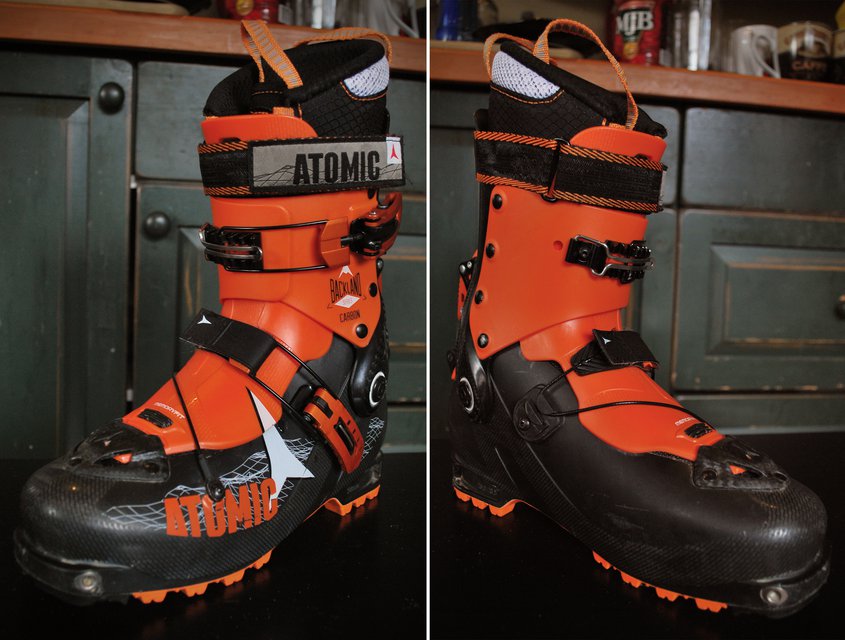
The Backland uses a much different system, one in fact very similar to the bottom buckle on a full tilt. One end of a cable is attached to the shell and the other end is attached to a buckle. The cable is passed over the foot and secures in one of tow slots on the inside of the shell.
To give more adjust ability the buckle head has 4 different options for the cable to sit in making it fairly easy to dial in the correct tightness over the foot. It does not offer quite the same amount of adjustability of that of a Full Tilt, but the buckle being permanently attached does improve durability and also saves weight. The end of the cable closest to the buckle has a small material cover which helps spread the pressure more evenly over the instep, an area which can often be a problem area in boot fitting.
Having the cable pass over the foot twice allows the pressure to be distributed more evenly over the top of the foot compared to if it only crossed in one place.
The power straps again point to the differences between the two designs. The Backland maintains the lightweight theme and goes for a minimal narrow power strap.
The MTN Lab in comparison uses a similar strap to that found on Salomon's race boot's. If you have used a Booster strap before, the MTN Lab uses basically the same thing. Yes it adds some weight but it will certainly improve the performance of the boots in ski mode.
Liner
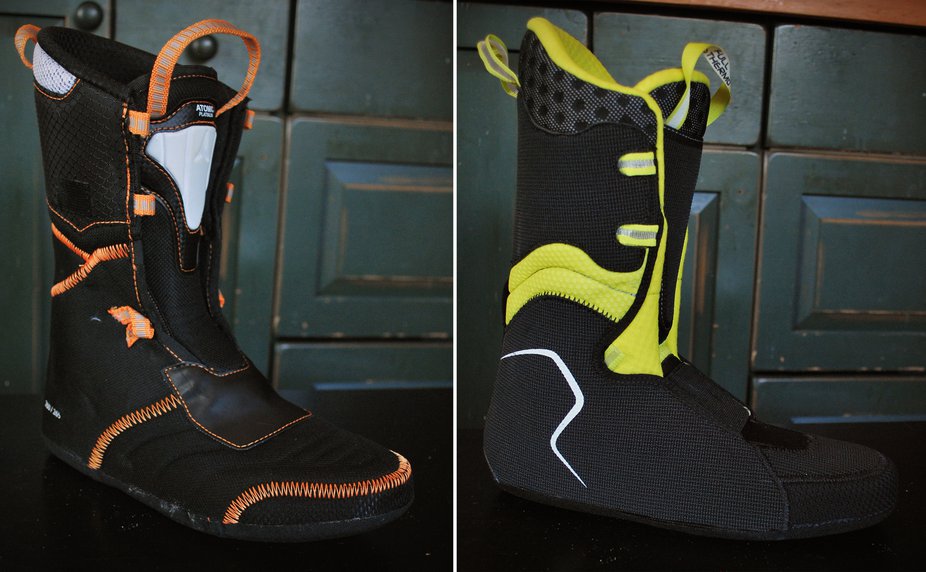
The liner is another area where the Backland really saves weight. Holding both liners the Atomic is noticeably lighter but it is also nothing like as padded or as supportive.
The Backland liner bends easily and only a 3 inch section at the top of the cuff and a small section on the tongue are re-enforced to stiffen the liner.
The Salomon is much firmer all over. The lower part is slightly more forgiving and a slight shape has been added for the ankle pockets. The cuff is stiffer still as is the tongue. Although it adds weight re-enforcing the liner like this will help stiffen the boot and make it feel more powerful.
When it came to adding my footbeds to the Atomic's I found something that did make me laugh. Atomic use in all their boots a thin volume reducer below the insole which can be removed to add volume. It maybe weighs 5g, but in the Backland Atomic have drilled holes in it to save every last gram they can.
Tiny details like this really show how much attention to detail has gone into the boots and how Atomic have managed to make such a light weight boot.
So after looking closer at both boots it would certainly seem that these are two very different boots.
The Backland is going after that true light weight touring market whereas the MTN Lab would seem to be aimed at more the big mountain touring skiers and to be honest probably more people here on NewSchoolers.
(Update - The Backland boots I have been testing are samples as production will have only just started as you read this. Although very similar the sample boots are not finished versions and I just got the chance to look at an updated production boot. The liner has been thickened slightly all over, to give some more comfort and the foam Atomic are using is also slightly denser so along with giving a slightly tighter fit it should give a slightly stiffer feel to the boot overall.)
The Fit
The first thing I wanted to do was shell check the length of the atomic. At 286mm BSL this would be by far the shortest boot I had ever skied, but upon inspection I had the usual 2 finger space behind the heel. If anything the Backland is slightly longer inside then the MTN Lab even though the BSL of the MTN lab is 15mm longer.
One point to note with both boots is, you would go with your regular alpine boot size. In Dynafit for example a 27 boot is actually a size 26 in alpine boots so you generally up size but with both the Backland and the MTN Lab you can ski them in your regular size.
Both boots have a 98 mm last and although most of the rear shell is fairly similar between the two the forefoot and toe are quite different.
Atomic have gone for a rounder toe box more similar to what you would find on the Redster boot.
The Salomon shape is a little different. The widest point for the forefoot is a little further back then on most boots and the toe does narrow on both quite quickly, leaving a rather narrow toe box.
On both boots I did find there were slight fit issues out of the box. Both boots were a little tight over the instep, although it's worth noting I do have a very high instep. The Backland was good in the forefoot but was very tight on my heels. The MTN Lab were good on the back of the foot but the forefoot and toe box were way to narrow.
Getting the boots to fit well showed just how effective Atomic's Memoryfit is. All I had to do with the Backland was heat the shell and liner for 12 minutes in the boot oven and put the boots on for 10 Mins to cool. I was going to use toe caps but in the end did not bother as I felt the length was good. I padded my instep a little but that was it. After letting the boots cool the fit was perfect. I did not have to do any other work to the boots and they felt great the entire time I was testing.
The Salomon's on the other hand took a little more effort. The MTN Lab is unfortunately not a custom shell boot so I had to do all the stretching manually. Although I don't mind this, it really did show me how effective the MemoryFit on the Backland is.
I have had to make a number of adjustments to the MTN Lab to get them working and to be honest they are still not quite as good as the Backlands. I'm sure with more work I could get them there but Custom shell or MemoryFit in Atomic's case really does make things much easier and also potentially cheaper for you, the customer. In many cases after the initial fitting customers need no additional work doing which could save you a lot of money on boot fitting.
One more point on the MTN Lab and this is more for the boot fitters out there, I did find the very thin shell marked easily when punched. Although the punches held and were fine I like boots to look good so I instead stretched with interna stretchers to give a cleaner job and this is how I would recommend doing it.
So with both boots fitted there was nothing left to do but try them out.
Climbing
Atomic
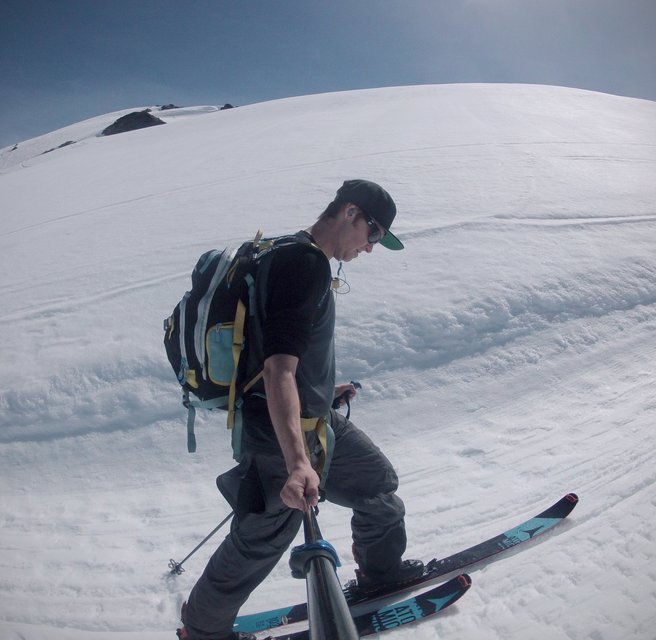
I received the Backland's about 10 days before the MTN Lab boots so my first few tours were all in the Backlands. Along with the boots, Atomic provided me with a pair of the 2016 Automatic 102 skis mounted with a Dynafit Radical ST binding.
Although not really the ski you would necessarily match up to these boots as they are not really that light (Atomic also have the Backland skis which are crazy light) it would give a good indication of whether the boots had the power to drive a slightly wider ski.
My first few hikes were up Flute which is just off the side of Symphony on Whistler mountain. Although not a tough hike it does give access to some decent terrain and using Symphony lift I was actually able to hot lap Flute and really get some miles on the boots.
The Backland's are the first boots I have used with the option of removing the tongue so excited to try it out my first few hikes I took the tongue out and took full advantage of the full ROM. The best way I can describe the feel of the boot in Walk mode is by saying it honestly feels like a Hiking boot. The cuff is almost completely friction free and without the tongue the motion is amazing. I have actually worn hiking boots with less motion in the ankle.
You may think this much movement could give an unstable feel, but by using Carbon in the cuff, Atomic have been able to really stiffen the cuff and there is never a sense of side to side play which could make things unstable.
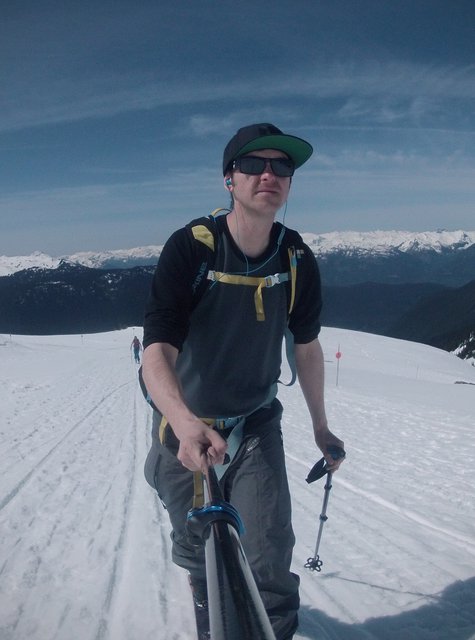
One thing I often struggle with touring is blisters on the heel and this was one area I was conscious of as it had been the tightest part of the boot. However never once I have got any type of rubbing or discomfort in any way and I put this down to a combination of two things.
Firstly to stop blisters you really want the foot held down, its when the heel lifts and rubs that you will get problems. The cable system used over the forefoot does a really good job of holding the foot down but without giving it a restricted feeling. Having the cable cross the foot twice means there is more hold over the instep then a single buckle.
The second aspect which really helps in my opinion is the liner it's self. Atomic have put a lot of work into not only making the liner light but also to make it as breathable as possible. When you get hot and sweaty in a liner, this can also lead to problems. Never once did I feel overly warm in the liners and even on the really hot days my feet were staying comfortable.
I did wonder how warm they would be on cooler days and although we have not had any really cold days to test them they do feel as though they would be ok but perhaps not the warmest. If in doubt a pair of heated socks from a brand like LENZ would be a great addition for cold winter tours.
I also tried a few climbs with the tongue left in and to be honest if I was doing shorter hikes (under an hour) this is probably how I would leave it. The ROM is still very good and when paired with a binding like the Radical I was still able to get up flute faster then I usually do. The fact it's a little faster to get skiing as you don't have to put the tongue back in at the top means if I was out chasing powder this would be the way I would go. Having as few things as possible to do at the top means more time for skiing.
The shell shape around the forefoot and toes has felt fine and I like the amount of space I have in the toes. Having your toes close to the front of the boot when climbing for a few hours can get quite uncomfortable very fast.
The weight, or lack thereof is undoubtedly helpful and if matched up with a lightweight ski and binding you could have a seriously light weight setup.
If climbing as many vertical feet in a day is your thing you will love these boots. The walk motion is simply un-matched and the weight is going to be hard for a lot of brands to beat.
Salomon
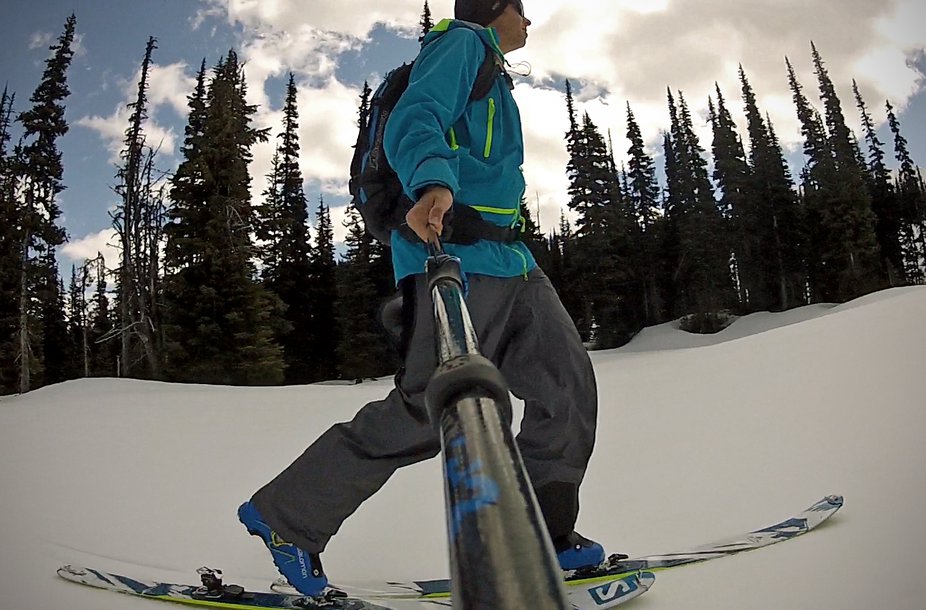
After being very impressed by the Backlands it was the time to see what the MTN Lab had to offer. Salomon provided me with quite a selection of skis to test, including 2 pairs of the MTN Explore Ski (95mm underfoot) one mounted with a Dynafit Radical and the other with a Salomon Warden binding. They also gave me a pair of the MTN Lab skis (115mm underfoot) again mounted with a Dynafit Radical so I could try the boots on some wider skis.
After getting my fitness up with the Backlands I decided my first tour with the MTN Lab boots should be with the slightly heavier MTN Lab ski. We had received quite a bit of fresh snow over night so the wider skis would be the more fun and luckily Salomon have done a great job at keeping the weight down and I would say they are actually lighter then the Automatics.
I initially started with the boots reasonably loose, like I do most boots to climb but I quickly found that I was getting to much movement inside the boots. I tightened the boots to close to how I would to ski them and found a much better overall experience. I have found that you can honestly leave the boots the same tightness to ski and walk and all you need do is flick the walk mode switch on the back. The way the shell and cuff are constructed allow the boots to move just as easily when tight as they do when lose. I really like this as again not having to adjust boots at the top really saves time.
The walking motion is again very good and the backwards motion is close to that of the atomic. The forward flex is certainly not as good but when in the binding you don't notice it too much, if at all. If you wanted more ROM and did not mind the slightly softer flex the MTN Explore boot does have a larger ROM, so if the uphill is more your thing the Explore may be the one to go for.
After a few shorter climbs I wanted to give the boots a longer climb to find out if you had too how far you could go in the boots.
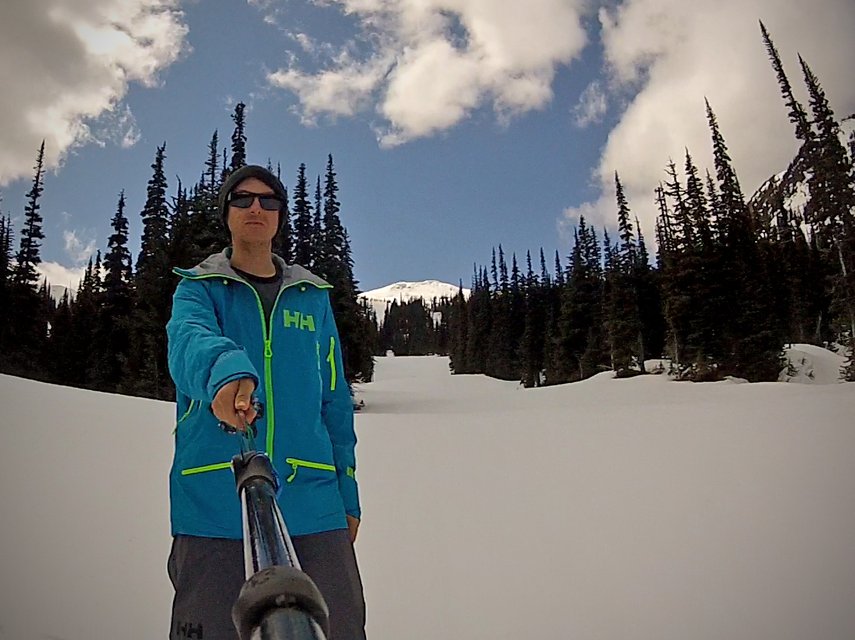
The peak in the distance is where I would be climbing too.
With Symphony lift closed I skied down through some of the glades to the bottom of the lift. It was turned out to be so much fun as no one had been down with the lift being closed, if only whistler could always be like this. At the bottom I put the skins on and set off to attempt to reach the peak of symphony.
I decided to give my legs every chance possible so went for the lightweight MNT Explore skis. Initially going was good but I was having some issues with rubbing on my left heel which did unfortunately get worse as I went along. I'm sure with a little more bedding in of the liner and maybe some shell work I could relive this issue but it was a little annoying.
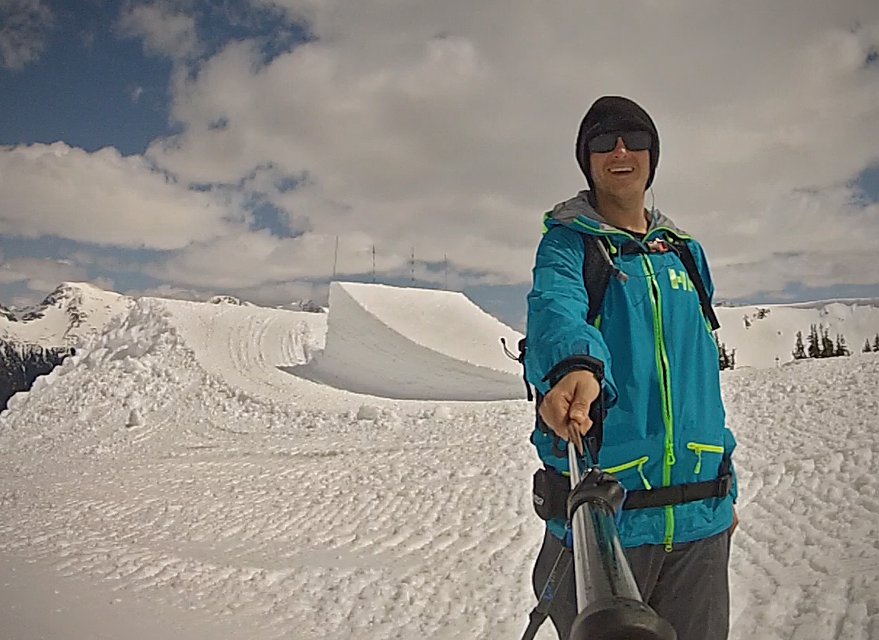
This is not what you would usually expect to find at the top of a climb.
Apart from the heel issue I was absolutely fine in the boots. Going for the MTN Lab is going to give you a far better climbing experience then most if not all freeride boots currently on the market. No it is not as good as the Backland uphill but it really is very good. Although I do think the Backland is a better option for longer tours I have been pleasantly surprised at how well the MTN Lab climbs.
Downhill
Atomic
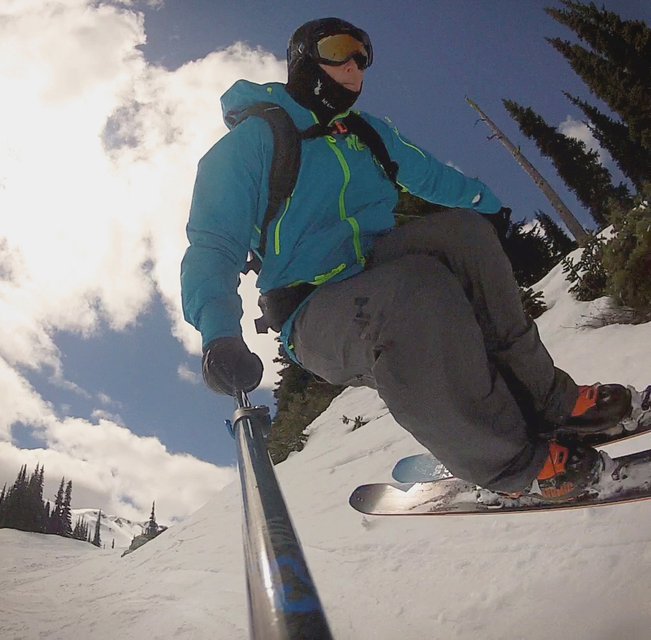
So the Backland would get you to the top no problem but would it actually get you down the other side?
My first few descents were all fairly mellow but considering how firm the snow was, this probably was not a bad thing.
With the boot in ski mode the forward flex is actually surprisingly stiff. The boots do have a rather unique feel, the cuff is not typical of what you would find on an alpine boot. It is rather low and only about 5cm tall at the front but when the tongue is installed the boot does have a good amount of support. It does take a little getting used too but I never worried too much about overpowering the boot. The lateral stiffness is amazing but you would expect that from a carbon cuff.
Its hard to say exactly how stiff the boots feel flex wise as they do have a different feel to most boots. I would probably put them around 110, they do feel softer then the MTN Lab in the forward flex but the lateral stiffness is up there with 130 flex boots I have used and it feels stiffer to me then the MTN Lab
I quickly got the confidence to really throw the boots into turns knowing they would support me and if anything I was finding I was being held back by the tech bindings more then anything but feeling fairly confident in the boots I decide to tackle a few of Whistler's bigger lines.
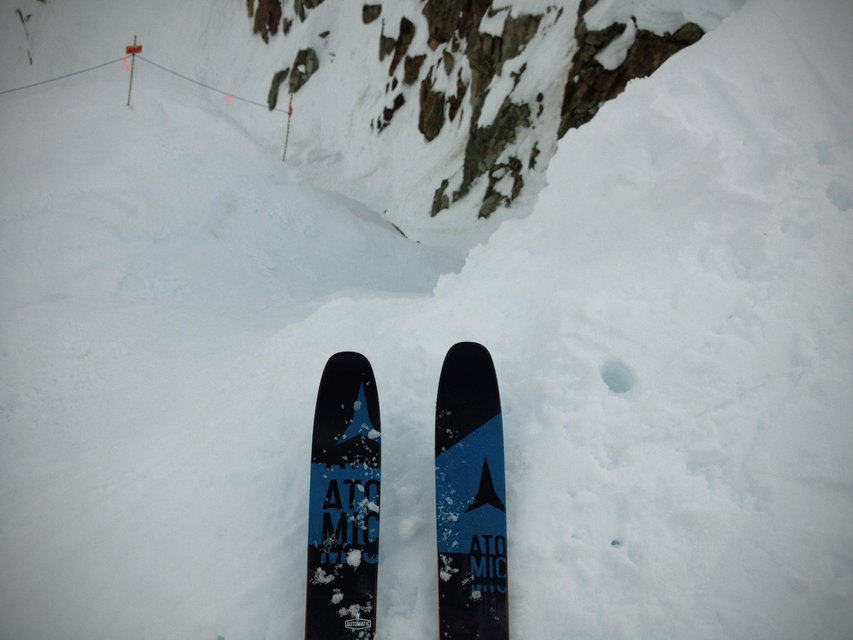
Although I have skied these lines before, I must admit I was quite nervous standing at the top. The cuff of the boot although stiff when locked does not feel the most supportive to me. Being so small at the front it does somewhat give the feeling your being held in the middle of the shin and not really anywhere else.
I have been finding when you are leaning the skis over and carving the support feels great, the carbon in the cuff really allows you to push the boots. However when your attacking a bit more and pushing into the front of the boot, I find the Small Grillamid cuff does not really offer the same level of support.
This became especially evident when skiing the wider skis like the 115mm MTN Lab. Carving the skis felt fine and initially I figured there was no issue with wider skis but once I started hitting a few jumps and bigger terrain head on I was finding that the boot was struggling a little and the ride did not feel too stable.
I really would not be considering these boots if your idea of touring is a climb to find a big mountain run. Wider skis and big drops will certainly push these boots to the limit and the feeling of the cuff never really inspires confidence in me to hit things as fast or as hard as I can. For more mellow descents these boots are great. If your climbing for a while to get to a non rowdy descent you should have no real problems at all.
Salomon

In my opinion one of the bigger selling points of the MTN Lab is the ability to use non tech bindings. With bindings like the Marker Lord or the Salomon Warden you could potentially use these boots on your alpine skis. Talking with people round town who have used the boots, quite a few are considering them as their only boot next season.
To see if they would compare to an alpine boot, I took out the MTN Explore skis with the Warden bindings so I could ski the boots hard and not be held back by the tech bindings.
To say they felt solid would be an understatement. When in Ski mode the cuff is so stiff backwards, there is no play what so ever and even compared to freeride boots like the K2 Pinnacle 130 or the Atomic Waymaker Carbon 130 the MTN Lab feels way more secure. This stiffness in the cuff really gives you the confidence to attack.
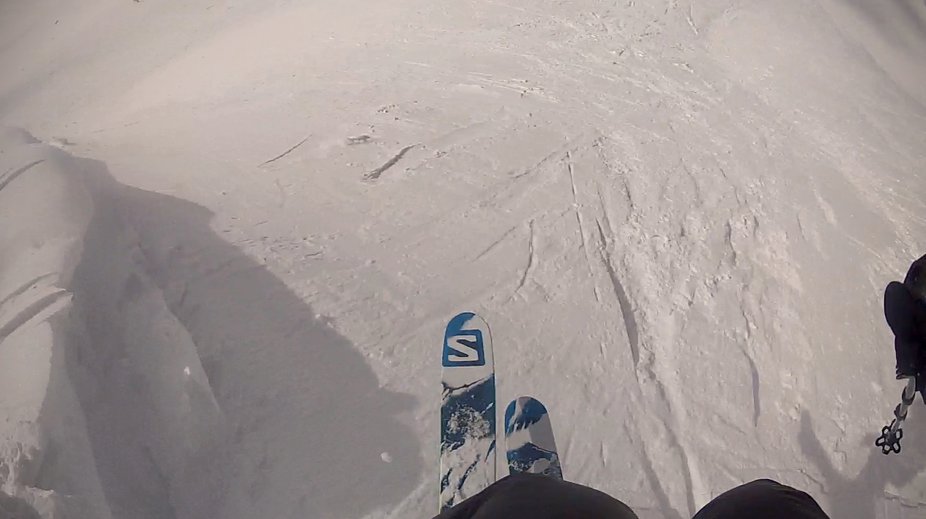
The forward flex is consistent and although perhaps on the softer end of 120 I have had no issues with the flex. The cuff does have the slightly softer lateral feel which is common to most Salomon boots but it is certainly still stiff enough to power the skis. I would say the Backland actually feels more powerful side to side but the MTN Lab does have a much more powerful forward flex.
I really can't feel any difference to a regular alpine boot and when you consider how well the boots walk you begin to realize just what a good job Salomon have done.
I also tried the wider MTN Lab skis to see how these boots would handle a wider ski and I was actually very surprised how well they did. Even with the Tech bindings I had confidence to throw the skis around and the boots felt solid at all times. I would not be worried at all about using the MTN Lab boots on wide skis.
Would I ride these boots in big, steep terrain? Absolutely, they feel as good if not better then a lot of alpine boots I have tried. I even took them for some park laps and although I may not use them as a dedicated park boot there is absolutely no reason you could not do a few laps every now and again.
If your aim for touring is to access some big zones these are your boots, seriously. All the power and control of an alpine boot but with the weight saving and ROM of a true touring boot.
Resort Riding
Atomic
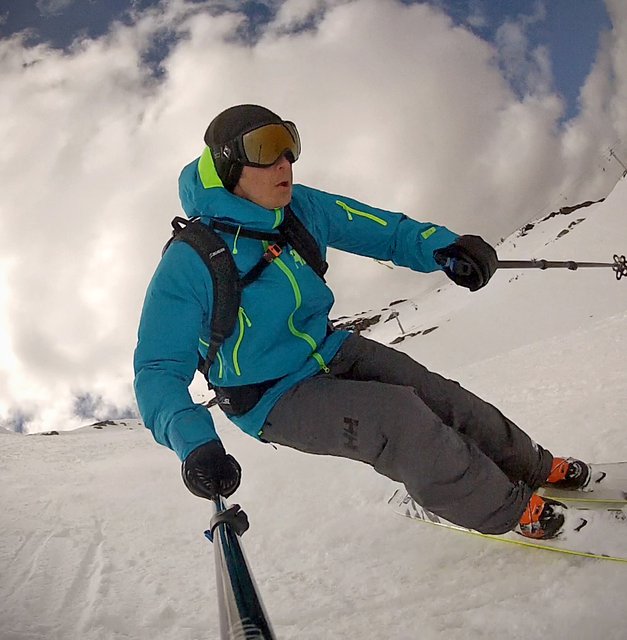
For many people having multiple pairs of boots is a nice idea but unfortunately not a possibility, so if you spent your hard earned money on the Backland's could you potentially use them as your every day boot?
Carving on groomers I must admit they feel excellent. The cuff is so stiff side to side you really can drive the skis very hard, I was laying down some big GS style turns with no problem at all.
While I was testing the boots we had a staff ski day and I decided to use the Backlands to see how they would handle a full day. Staff ski days, if you have never been on one, tend to be a lot of drinking and a lot of messing about, hitting stupid stuff. This day was no different and I was drunk by 10am. The rest of the day was spent straight lining things and jumping over stuff or attempting too at least.
I will admit I could not ride quite as hard as normal but it was not really the boots holding me back but rather the bindings. Even with the toe locked I had a few big pre-releases and some big falls. But that is me trying to ride a Dynafit in bounds as hard as I would my STH 16 steels. If your average riding is not too aggressive the Backland will do fine.
Other then the bindings the only real issue I found after a long day was the shins did get a little sore. The lower cuff and the minimal liner don't offer much in the way of protection but this is one area the boots are being improved before release next season.
So although perhaps not the boot the average Newschooler would choose to ride inbounds you certainly could do a few days resort riding in the Backlands.
Salomon
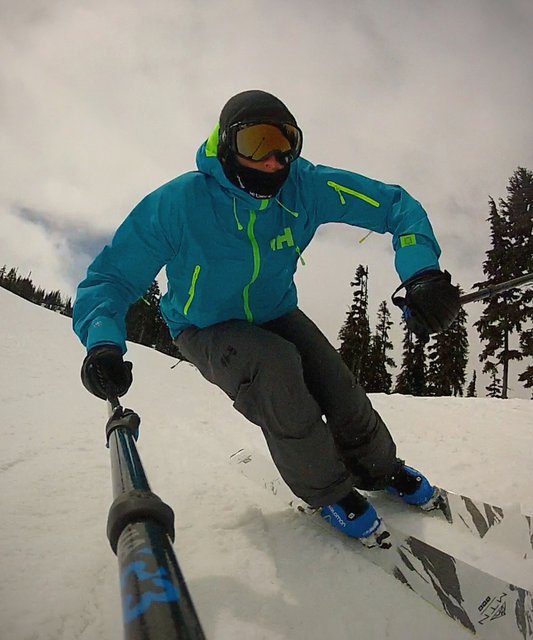
I covered most of the resort riding elements in the last section for the MTN Lab but I really do believe these have the potential to be your only boots. There is nothing I have found that the boots can't handle and they give better all day comfort then the Backlands, up there or beating many alpine boots. You could potentially buy this boot and never tour but still be very happy with your purchase.
A lot of people will have bindings which will work with these boots and if you are looking at bindings in the future consider going for something like the Warden which will give you a lot of boot possibility's.
I will admit I am strongly considering these as my main boot for next season as there offer everything I need. Yes the Backland is better on the way up but for how I tour the MTN lab would be a far better option as I could ski them as hard as I wanted on the way back down, which for me is still the reason to tour in the first place.
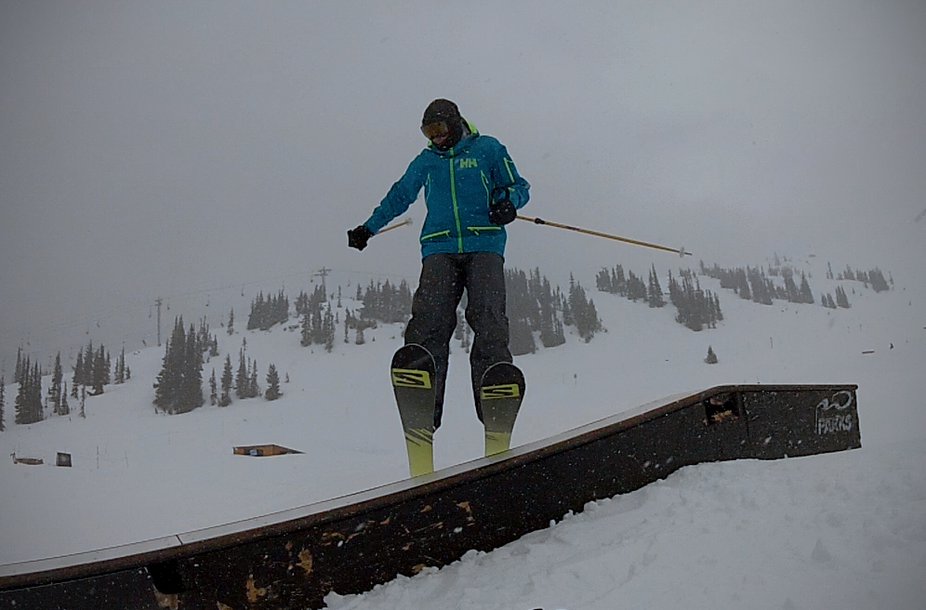
I had to have at least 1 park picture
Comparing to Other Boots
I was hoping to borrow a pair of light weight touring boots such as the Dynafit TLT6 but unfortunately my hook up fell through and I was not able to try any out. I was however able to test the MTN Lab against one of the current top selling boots, the Dynafit Mercury.
MTN Lab vs Mercury
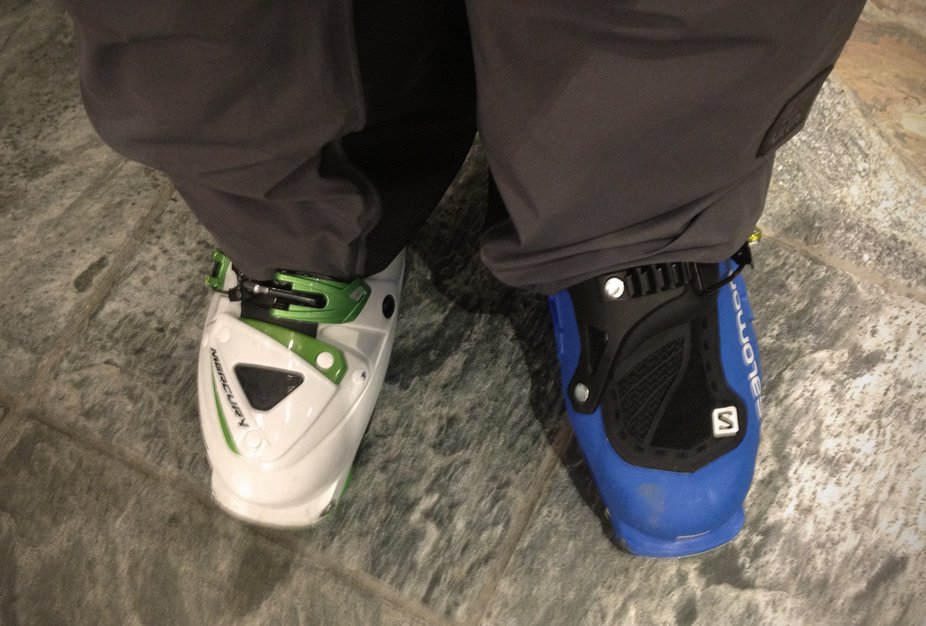
Unfortunately the day I tested both boots I forgot to put the memory card in the GoPro so this is the only shot I have.
If you are not to familiar with the Dynafit Mercury boot, it is one of Dynafits higher end touring boots designed for more aggressive riding. The other high end boot is the Vulcan and the Vulcan is actually replacing the Mercury next season but I was not able to get hold of a Vulcan to test so the Mercury gives a very good equivalent.
When I went to collect the boots I had a chat to the manager of the shop as he had tried both the MTN Lab and the Backland. The shop where I was borrowing the boots is one of the real hardcore touring shops in whistler and the guy's there know there stuff when it comes to touring and one of the things the manager said surprised me.
He said one of his favorite features on the MTN Lab was the fact there was no tongue to remove. I did think this was a little odd as I had found so many good features but I grabbed the Mercury's and headed off up the hill.
Like I did when I compared the SPK to the Ghost FS 90, I decided to wear one boot on each foot. Although looking rather odd I do find it really allows you to feel the differences.
My first few runs were using the Explore skis with the Wardens to see if I could notice any differences skiing. In all honesty they felt very similar. The forward flex felt nearly identical, the Mercury felt a little stiffer laterally but the MTN Lab felt more solid backwards in the cuff, however some of this was to do with the Mercury's being about a season old.
I would be hard pressed to tell the difference if I did not know which boot was on which foot, so the downhill performance was pretty evenly matched, but how would they handle the uphill.
I switched to the MTN Lab skis and set off hiking to the Peak of Whistler from the Roundhouse. I was heading up the road which runs up Harmony and although not a hard or steep hike, it is quite long. In no time whatsoever I could tell just how much more effective the Walk mode on the MTN Lab was.
To be honest, I had noticed just how much better the MTN Lab was just walking around shop, but once your climbing it really becomes apparent just how good the MTN Lab is. The Dynafit does not have anything like as much ROM with the tongue in and even with it out I still prefer the movement of the MTN Lab.
Having tried both I understand what he meant about not removing the tongue being a big bonus. The MNT Lab will walk better and ski just as well as the Mercury all by simply flicking one switch. Although removing the tongue does not take long it is just one extra step you need to take.
I do also much prefer the way the walk mode is kept separate of the top buckle on the MNT Lab. Its not a big thing but I do find I catch the top buckle of Dynafit quite often when its open.
Overall I must admit I was very impressed by the MTN Lab. I expected them to ski close to or as well as the Dynafit but I expected them to fall behind on the climbs. In reality the MTN Lab really out paced the Mercury on the climbs something I really did not expect.
If you have skied Dynafit boot's and your considering giving these a try I really urge you do it, you will not be disappointed.
Overall
This has been one of the more interesting boots reviews for me as the outcome was really not what I was expecting.
I had been reading all the information about the Backlands for a while and I was fully expecting to say that the Backland is the new best boot in the world, and for certain things it is, don't get me wrong. For climbing the Backland is pretty much unmatched especially in a boot you can still ski reasonably hard in.
But that is my issue with them, skiing reasonably hard. I want to ski hard and the Backland for me at least is not really the boot to do it in. A big part of that is the fact you are so limited by bindings. The only tech binding I would want to ski is the King pin and unfortunately currently the Backland will not work with a Kingpin. So I would be stuck with a Dynafit and although I am starting to like tech bindings, throughout testing I did manage to break one of the three pairs of bindings, so for how I ski these are not the boots for me.
But if I was going touring solely to get out into the middle of nowhere and the descending would be reasonably gentle these would absolutely be the boots I reach for, but its not really the Backland boot I'm excited about its the boots which could possibly come from the research involved in making the Backlands.
So Backland may not be for Newschoolers but the boots which could potentially follow, really could change ski boots for ever.
The MTN Lab on the other hand really had not appealed to me before testing. I had not really looked at much of the technical information but I figured it was just a Quest modified slightly. How wrong I was.
The MTN Lab really is quite astonishing. Quite how Salomon have managed to make a boot so light yet still so powerful is amazing. If you plan on getting out into the backcountry but don't want to be held back in anyway, this is the boot for you. Match it up with a Duke or Guardian and you can charge anything, but if you want to use it for longer tours with something like a Dynafit you will have no issues at all.
I want these boots in my life and this is not something I have said about a Salomon boot for a few years now. I know its cool to hate on Salomon but the MTN Lab really is something quite special and I cant recommend it enough.
If these boots have sparked your interest in getting out into the backcountry I have a few more reviews of products I was testing at the same time as the boots. There are full reviews coming for the Helly Hansen Ullr Outerwear I'm wearing in this article along with a full review of the Julbo Areospace touring googles but for now check these out;
G3 Via Carbon Poles
The G3 Via Carbon pole has become my go to set of poles and you will no doubt recognize them from many of my photos.
Read my full review here
Dissent SkiProFit Compression Nano Tour
Boots like these deserve good socks and in my opinion Dissent make they very best you can buy. Do your feet a favor and check them out.
Read my full review here
Slytech Backpack Pro NoBounds 10
A good pack is essential when touring and this pack from Slytech not only works well but it can protect you too with its built in back protector.
Read my full review here
Next week its back to the park for my reviews. To start the week I have a Pro Rider Setup article featuring Noah Wallace. Next up is a review of the Virtika outerwear and all I'm going to say is you will want to see this. To finish the week I have the first full review of the new Full Tilt Descendent 8 so if park is more your thing check out the articles next week.
Thanks to Chris and Ryan at Salomon, Steve and Julius at Atomic, Christina at Helly Hansen, Gab from Slytech and Frederick from Julbo for there help in this review.
To keep up to date with what I'm currently testing follow me on Instagram @Tompietrowski

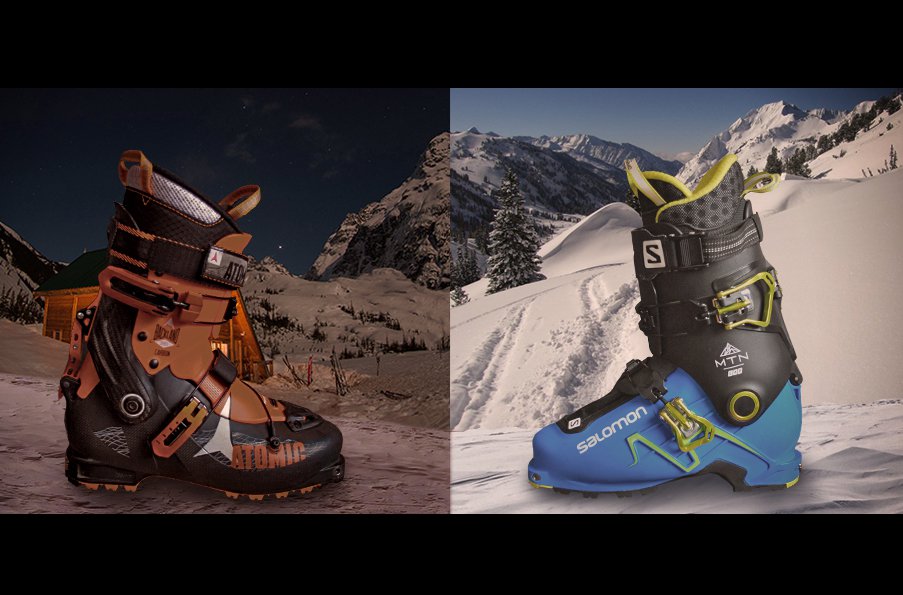
Comments